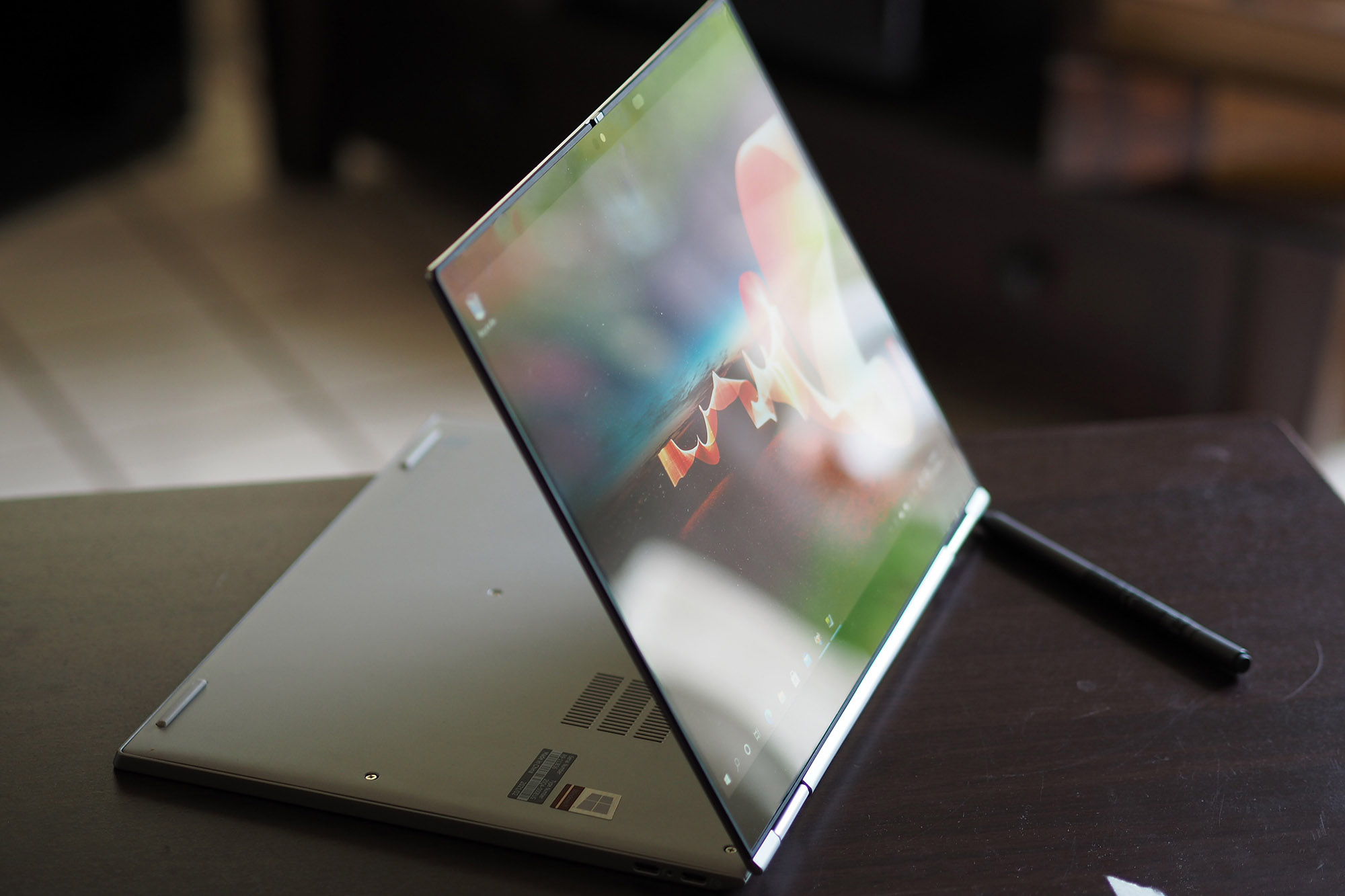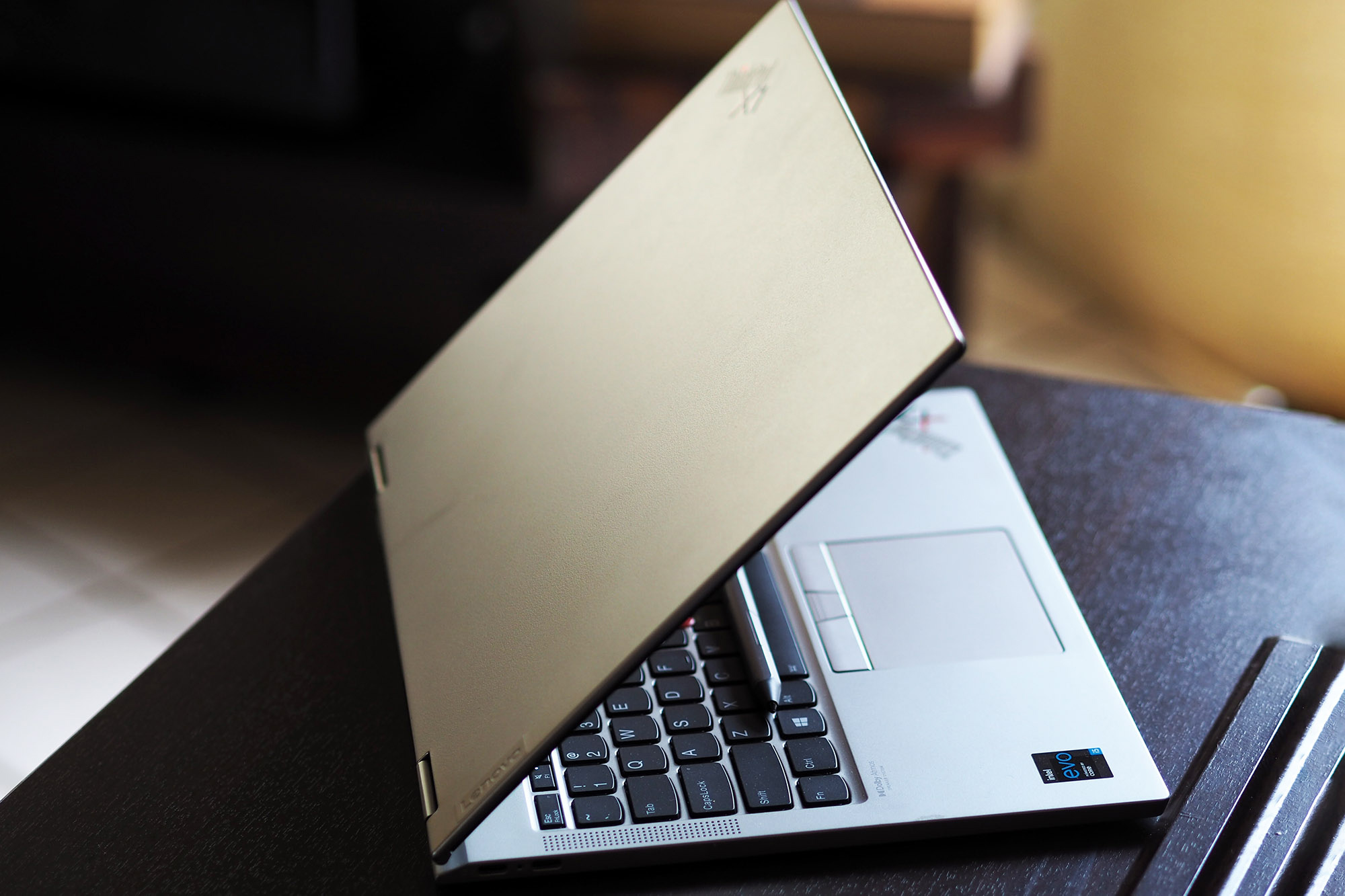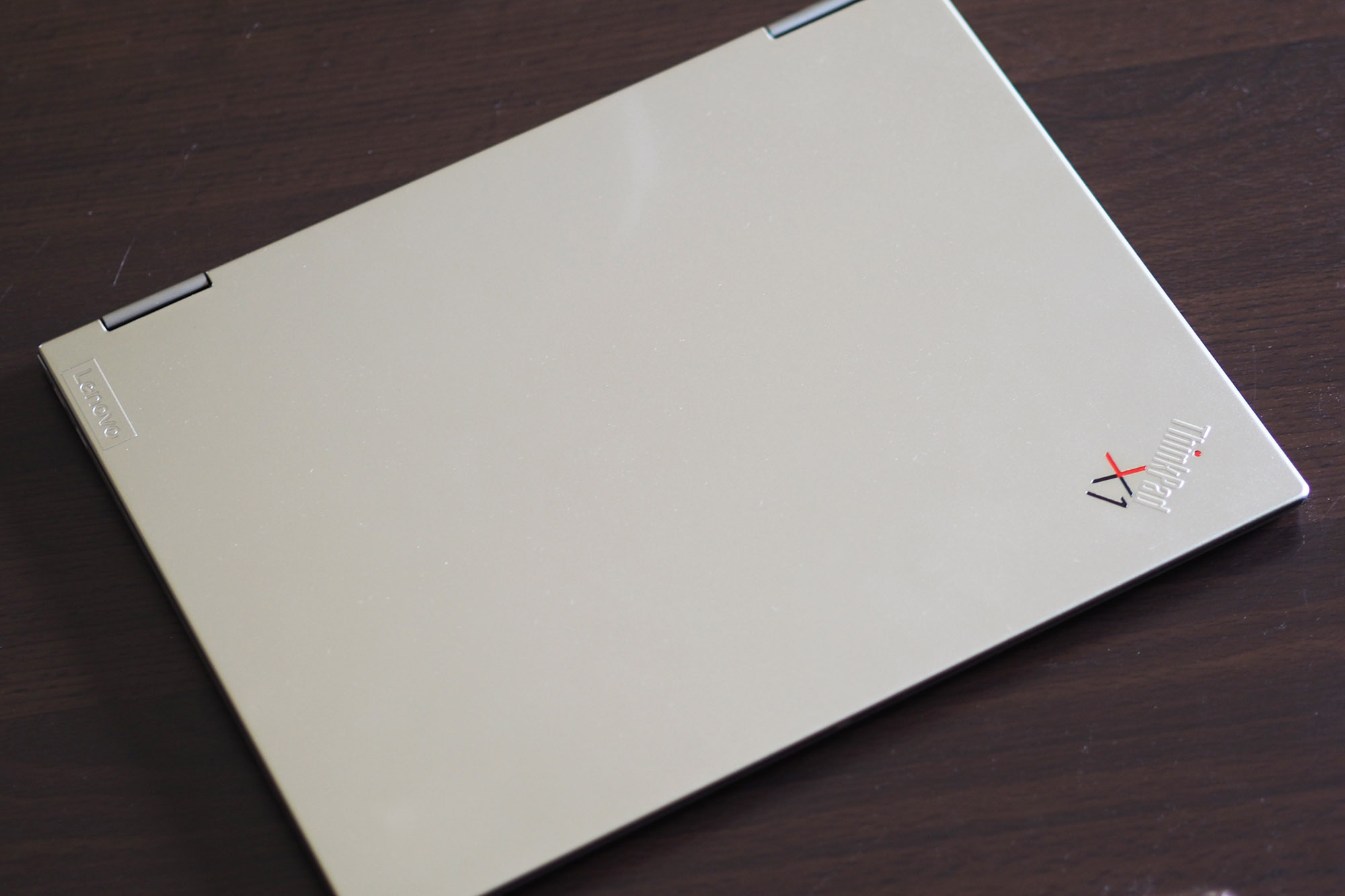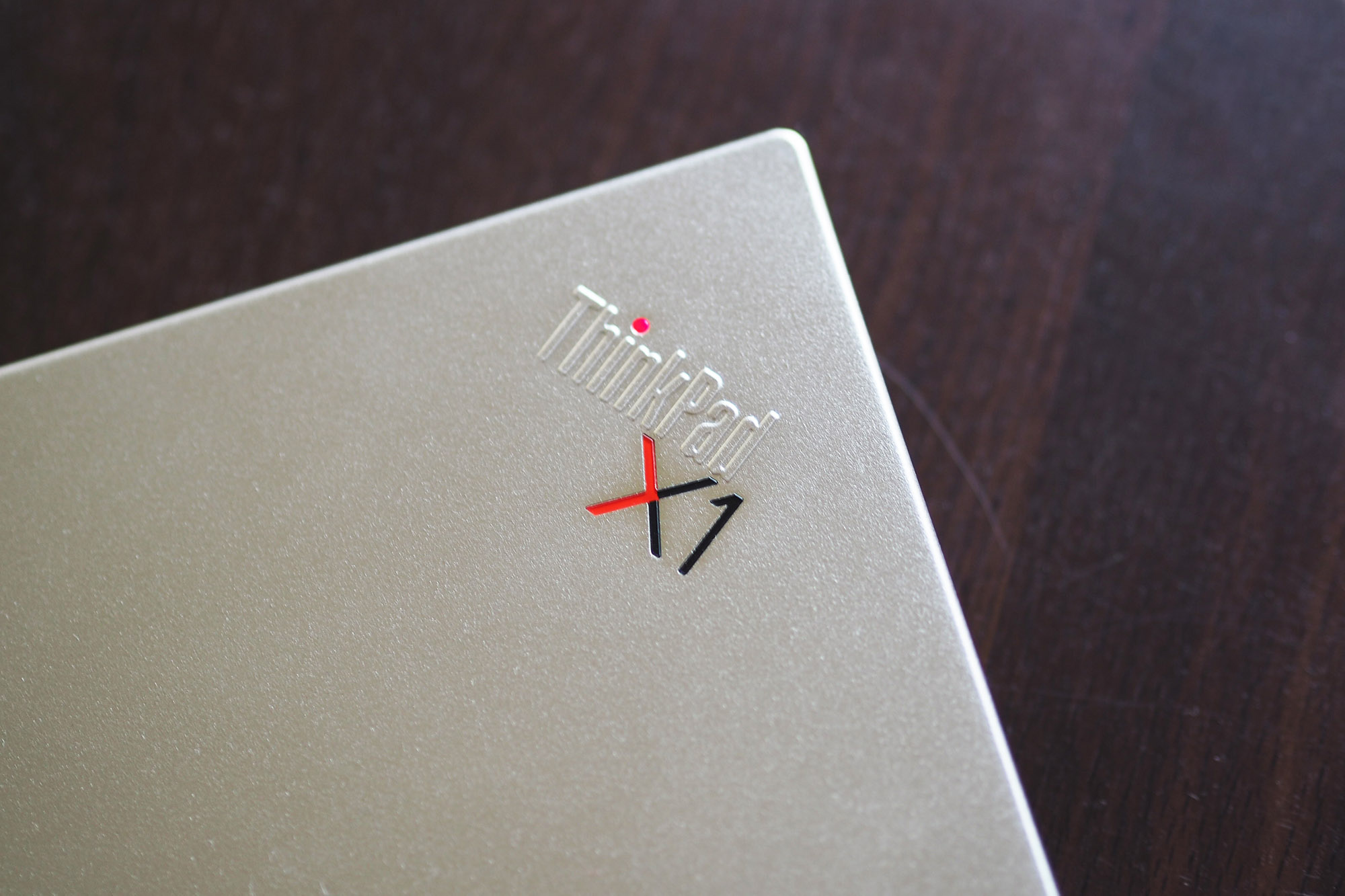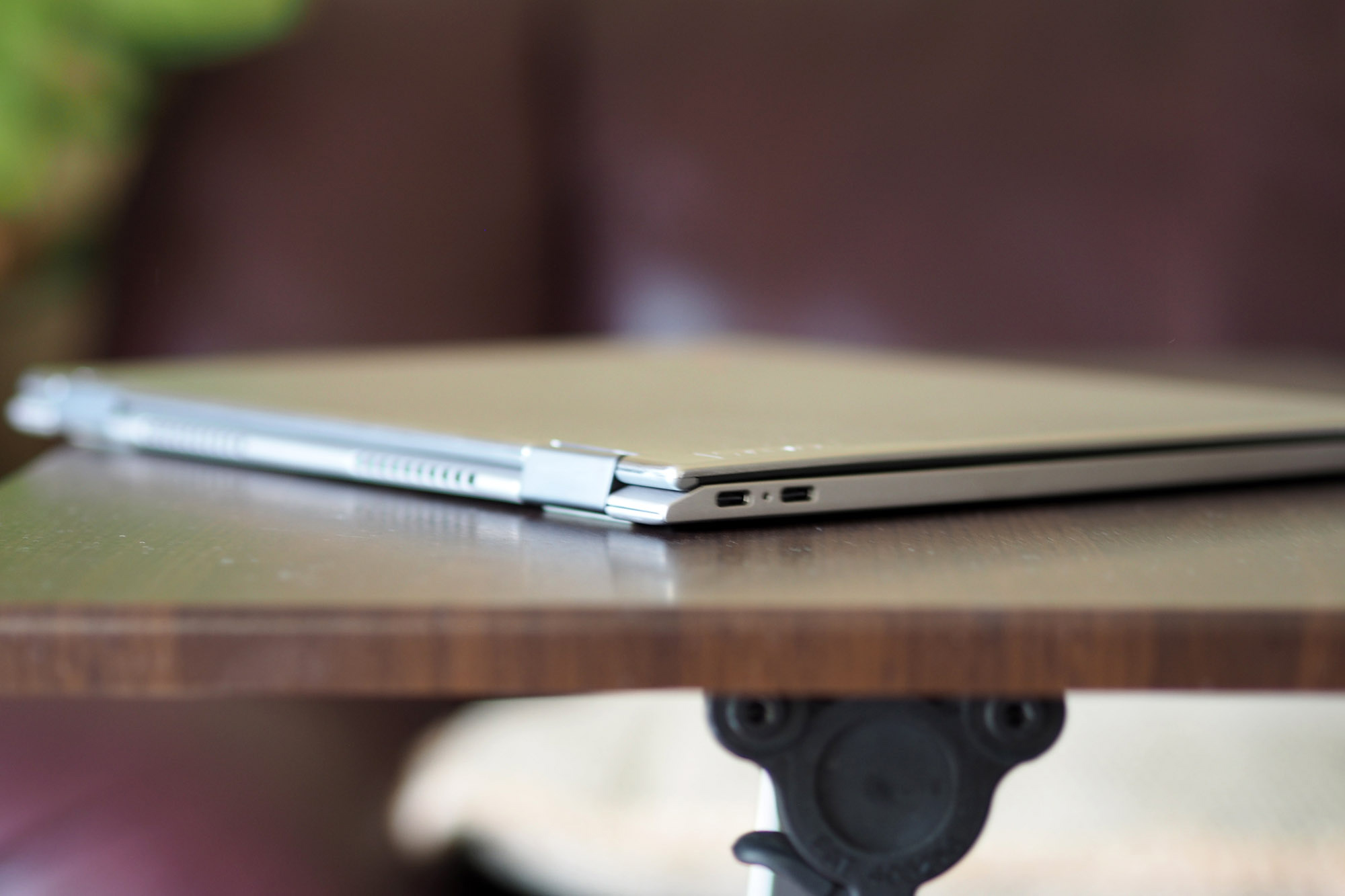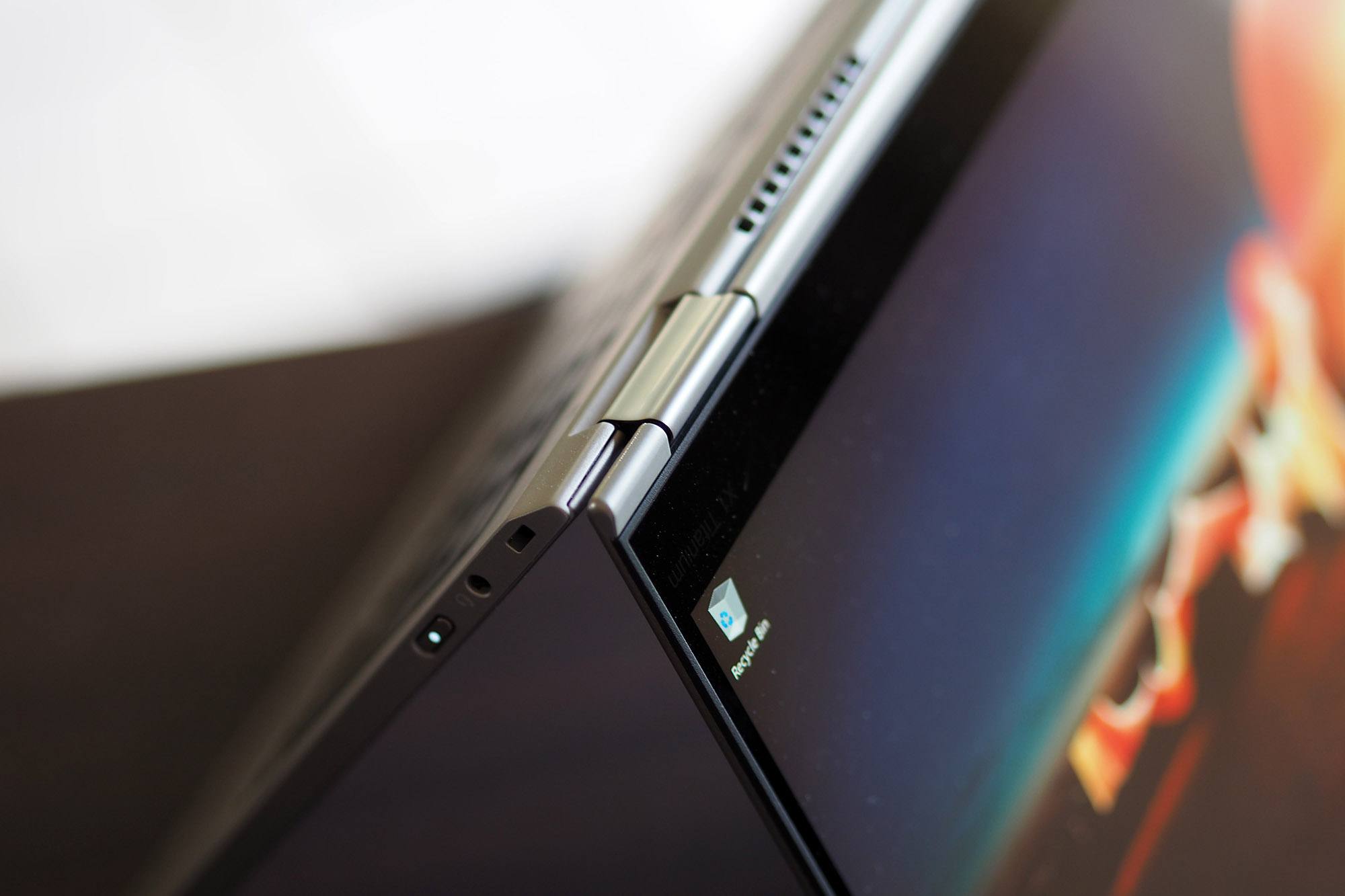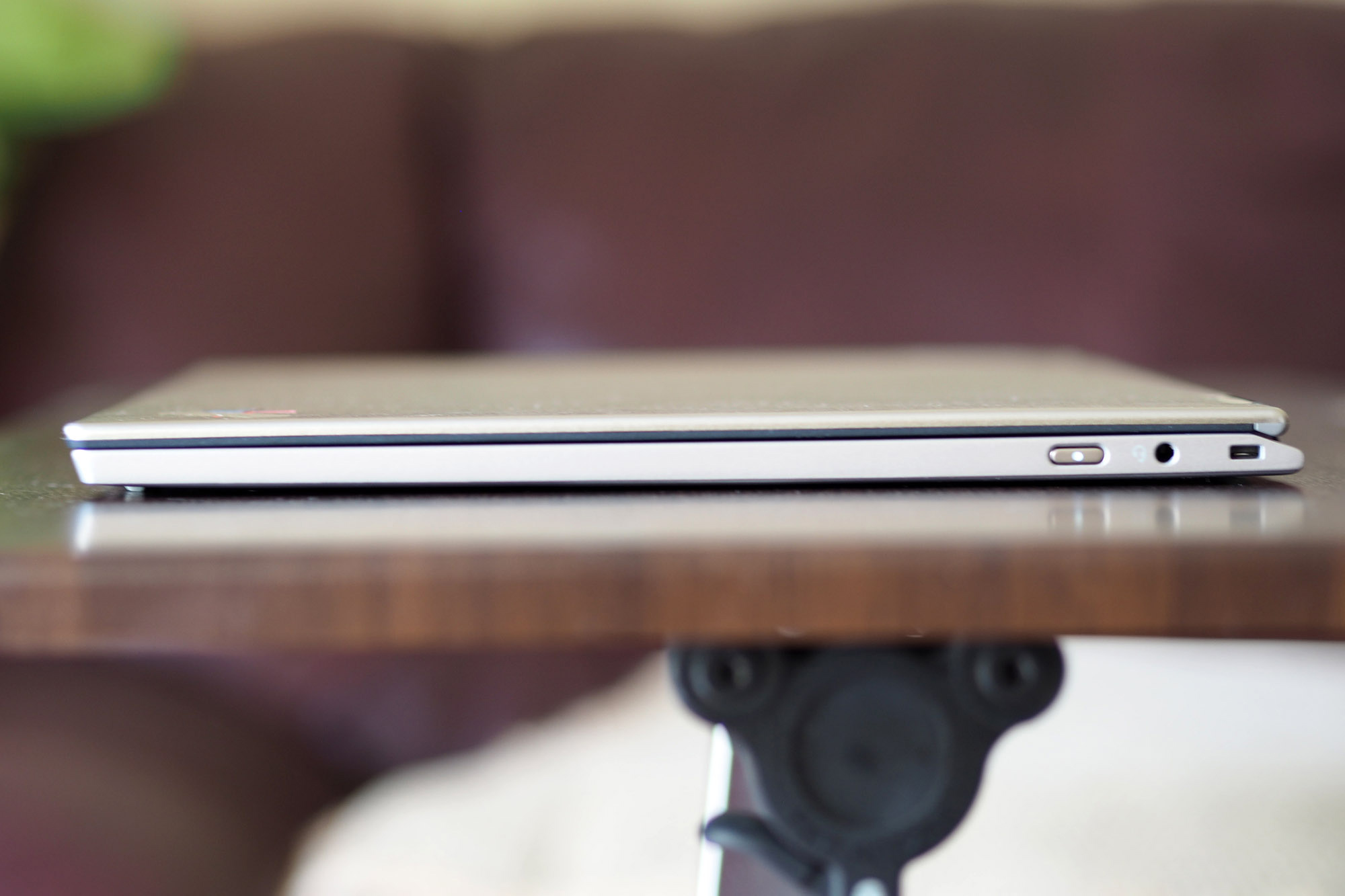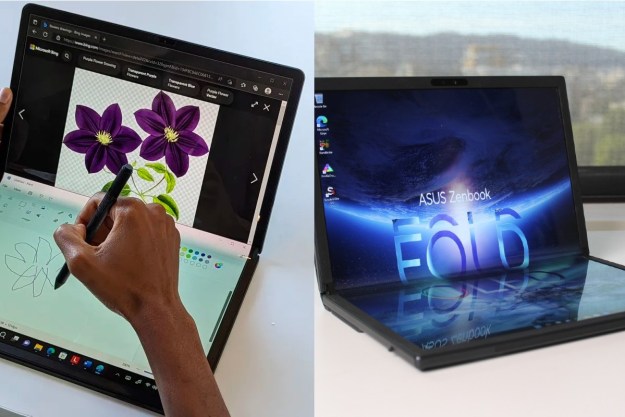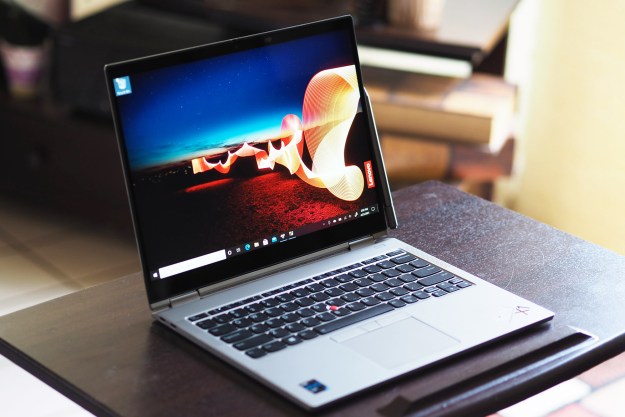
“The ThinkPad X1 Titanium Yoga is the best convertible 2-in-1 around if you want to use it as a tablet.”
- Attractive and innovative chassis
- Insanely thin and light
- Solid performance
- Excellent battery life
- Great display for productivity users
- Touchpad is too small
- Expensive
Remember when Lenovo’s ThinkPad line was the old standby, a collection of well-built and highly functional but often boring business laptops? Well, no more.
That’s a good thing, because what’s replaced it is a far more dynamic lineup that never ceases to surprise. The latest example is the ThinkPad X1 Titanium Yoga, an exciting new entry in the convertible 2-in-1 laptop category that — on paper at least — promises to compete with some of the very best laptops you can buy.
I received a midrange version of the laptop, with a Core i5-1130G7, 16GB of RAM, a 512GB PCIe solid-state drive (SSD), and a 13.5-inch display in the productivity-friendly 3:2 aspect ratio and with a high QHD (2,256 x 1,504) resolution. That’s the only display option available, a potential weakness that we’ll discuss later. The price for this configuration is $1,685 after e-coupon (the list price is an insane $3,369), making it a very premium 2-in-1 indeed. Let’s find out if the ThinkPad X1 Titanium Yoga has what it takes to take on the best?
Jump to: Design | Security | Performance | Display | Keyboard and Touchpad | Battery Life | Our Take
Design
Let’s start with this: Titanium is a really cool metal used in airplanes, among other things. Using it in a laptop is even cooler, and so what if it’s only used in the ThinkPad X1 Titanium Yoga’s lid? It’s there, and although it gives the laptop a cumbersome name, I like it. It has a nice texture that’s a play on the ThinkPad’s usual soft-touch material. At least, I assume that’s the titanium I’m touching, given that the lid is made of both titanium and carbon fiber.
The rest of the chassis is a magnesium-aluminum alloy meant to make it both light and durable, and while it succeeds in being very light at just 2.54 pounds, there’s a tiny bit of give in the lid and keyboard deck when some pressure is applied.
The HP Spectre x360 14, the most direct competitor to the ThinkPad, weighs in at 2.95 pounds and feels more solid — and both differences are noticeable. Also noticeable is the difference in thickness, with the ThinkPad X1 Titanium Yoga at just 0.45 inches thick compared to the relatively chunky Spectre’s 0.67 inches. The Spectre x360 14 is smaller than the ThinkPad X1 Titanium Yoga — specifically, it’s not as deep while being almost exactly as wide — thanks to smaller top and bottom bezels. The Dell XPS 13, the best clamshell competition, comes in at 2.8 pounds and 0.58 inches thick. It also feels more robust than the ThinkPad.
The ThinkPad would have benefitted from smaller bezels all around, although the top bezel needs its extra size for some additional components (details can be found in the security section that follows). The XPS 13 is the smallest of the bunch, but it doesn’t have to contend with a more complex 2-in-1 hinge. Speaking of the hinge, the ThinkPad X1 Titanium Yoga’s is a bit stiff, requiring two hands to open but keeping the lid where it belongs in clamshell, tent, media, and tablet modes. Note that tablet mode is more comfortable on the ThinkPad X1 Titanium Yoga than many other convertibles, thanks to its thin chassis and 3:2 aspect ratio that’s closer to a piece of paper in dimensions.
So, how does this thin and light laptop look? Well, to begin with, it barely resembles its all-black ThinkPad siblings. It’s a pleasant silver-gray color that eschews all adornment except the logos. Even those are different than usual, with the ThinkPad logo on the lid being a silver embossed version rather than the norma; white, although the “i” dot remains a blinking LED that conveys information about the laptop’s status. Directly beneath that is a more pronounced X1 logo that’s a mix of red and black, and it looks sharp against the ThinkPad logo. At the rear is an inset Lenovo logo that’s barely visible.
Open the lid and you’ll find a similar logo on the keyboard deck, the usual red TrackPoint nubbin, and the recognizable ThinkPad keyboard. The TrackPoint buttons above the touchpad skip the red accents, which I think works here. Overall, this is a very modern yet conservative design that I like a lot, almost as much as I like the Spectre x360 14’s gem-cut design and the XPS 13’s more streamlined appearance.
Unsurprisingly with such a thin machine, connectivity is at a minimum. You get two USB-C ports with Thunderbolt 4 support, one of which is used to power the ThinkPad X1 Titanium Yoga, a Kensington lock port, and a 3.5mm audio jack. That means you’ll need dongles for any legacy devices and a docking station if you need to connect more than one device at a time. Wireless connectivity is state of the art, with Wi-Fi 6 and Bluetooth 5.1, and there’s an option for
Security
The ThinkPad X1 Titanium Yoga has the usual ThinkPad security features, such as the ThinkShutter privacy switch for the webcam and the match-on-sensor fingerprint reader. But it also includes the human presence device (HPD) technology and software that I tested on the ThinkPad X1 Nano and found to be fast and reliable.

Basically, HPD, which is configured in the “Intelligent Security” section of Lenovo’s Commercial Vantage utility, uses radar to recognize when a user is in front of the laptop and when that user walks away. In the latter case, the technology first dims the display and then eventually — how fast is user-configurable — puts the laptop to sleep (specifically, into Modern Standby). Once the user returns to within a 60-degree arc from the front of the laptop, the machine wakes up and uses Windows Hello to log the user back in. If the infrared camera and facial recognition are set up, then the process is seamless. Walk away, the laptop goes to sleep; return, and it scans your face and you’re back to work.
The feature works well, and it’s great except when you’re running a long process that shouldn’t be interrupted. For example, I had to turn HPD off during my longer benchmarks and battery tests unless I wanted to stay locked in front of the laptop. Otherwise, my tests would be interrupted — imagine a long video-rendering session, and you’ll get the idea. I tested the same kind of technology on Dell’s Latitude 7400 2-in-1, and I’ve found Lenovo’s solution to be more reliable and seamless.
Performance
My review unit used the Core i5-1130G7, a version of the 11th-gen Tiger Lake Core i5 with a lower thermal design power (TDP) of seven to 15 watts rather than the usual 12 to 28 watts found in the Core i5-1135G7, as well as a max turbo frequency of 4.0GHz versus 4.2GHz. It includes Intel Iris Xe graphics with the full 80 execution units but at a slower clock speed of 1.1 GHz versus 1.3 GHz. All this is to point out that Lenovo opted for a slower and cooler CPU for the Thinkpad X1 Titanium Yoga, which makes sense given the laptop’s thin chassis. Note that this same CPU equipped the ThinkPad X12 Detachable tablet that I reviewed, which, as you can see from the chart below, was slightly slower than the ThinkPad X1 Titanium Yoga in most of our tests.
As you can also see in the chart, the ThinkPad keeps up in Geekbench 5 but falls behind in the other benchmarks. Notably, it outperformed the Lenovo Yoga 7i and its faster Core i5 in the 3DMark Time Spy GPU test, but that didn’t translate to real-life gaming. Otherwise, the ThinkPad X1 Titanium Yoga performed right in line with what you might expect given its CPU.
Note that where a machine offered switchable performance modes, I recorded results from the “normal” setting. In most cases — including with the ThinkPad X1 Titanium Yoga — there’s only a marginal difference between “normal” and “performance” modes. One outlier is the HP Spectre x360 14, which led the field in performance mode while its normal mode is quite a bit slower.
| Geekbench (single/multi) |
Handbrake (seconds) |
Cinebench R23 (single/multi) |
PCMark 10 | 3DMark Time Spy | |
| Lenovo ThinkPad X1 Titanium Yoga (Core i5-1130G7) | 1353/4852 | 251 | 1274/3705 | 4498 | 1339 |
| Lenovo ThinkPad X12 Detachable (Core i5-1130G7) |
1352/4796 | 185 | 1125/3663 | 4443 | 926 |
| HP Spectre x360 14 (Core i7-1165G7) | 1214/4117 | 236 | 1389/3941 | 4728 | 1457 |
| Dell XPS 13 (Core i7-1165G7) | 1540/5432 | 201 | 1449/4267 | N/A | 1589 |
| Lenovo Yoga 7i (Core i5-1135G7) | 1357/4246 | 207 | N/A | 4565 | 913 |
| Lenovo ThinkPad X1 Nano (Core i7-1160G7) |
1466/5139 | 180 | 1377/4550 | 4600 | 1549 |
The ThinkPad X1 Titanium Yoga’s PCMark 10 scores were particularly interesting. It was slightly behind on the main score as listed in the chart, but more importantly, it was particularly slow in the Content Creation portion of the benchmark. This carried over to our Handbrake test, which encodes a 420MB video as H.265, where the ThinkPad X1 Titanium Yoga was even slower than the ThinkPad X12 Detachable by a fair margin. Overall, this laptop performs well enough for typical
This laptop shouldn’t be picked for its gaming prowess. I ran Fortnite at 1080p (in a window, since the only full-screen option was the display’s full resolution where performance would have been terrible), and it managed 23 frames per second (fps) in high graphics and 17 fps in epic graphics. That’s about 10 fps slower than most other Tiger Lake
Display
Lenovo built the ThinkPad X1 Titanium Yoga around a 13.5-inch IPS display in the productivity-friendly 3:2 aspect ratio and with a high resolution of QHD (2,256 x 1,504). As mentioned earlier, the 3:2 aspect ratio makes this thin and light laptop a superior tablet compared to most other convertible 2-in-1s — including the HP Spectre x360 14, which enjoys the same aspect ratio.

But a display also needs to look good, and that’s where my colorimeter comes in. According to that device, the ThinkPad X1 Titanium Yoga’s display meets the modern premium average in some respects and exceeds it in others . For example, it’s quite bright at 431 nits, well above our preferred 300-nit threshold and better than most. The Spectre x360 14’s OLED display “only” came in at 374 nits, while the Dell XPS 13’s
The ThinkPad X1 Titanium Yoga’s display was less impressive in the colors department. It managed 71% of AdobeRGB and 96% of sRGB, which is just average for premium displays. The XPS 13

In real-world use, I find out it to be a pleasant display to work on, thanks to the high contrast that produced dark blacks on white backgrounds and plenty of brightness. It’s not going to please creative professionals who crave wide and accurate colors, but productivity workers will love it. The
Audio quality was a mixed bag. Volume from the dual downward-firing speakers was just loud enough and there was little distortion. Highs were a bit blown out, though, leaving the midrange to fight for attention. Bass, as usual, was nonexistent. The sound quality is fine for the occasional YouTube video, but if you want to binge Netflix or listen to music, then a good pair of headphones or Bluetooth speakers is recommended.
Keyboard and touchpad
The ThinkPad X1 Titanium Yoga has the same basic keyboard as the rest of the ThinkPad line, with identical sculpted keycaps and excellent spacing. It’s a bit shallower, though, with good travel but not quite as deep as you’ll find on larger ThinkPads. This is an improvement: I find some other ThinkPad keyboards to require too much force to register a click. Here, the feel is light, crisp, and very precise, with confident bottoming action. It can’t quite live up to my favorites, HP’s Spectre keyboards and Apple’s latest Magic Keyboard, but it’s close.

The typical ThinkPad TrackPoint sits in the middle of the keyboard and works as well as usual if you’re into that sort of thing. Its biggest drawback is that it requires a set of buttons that takes space away from the touchpad. That’s a bummer, because one of the advantages of a taller display is more space on the keyboard deck for a larger touchpad. Lenovo didn’t take advantage of this space, leaving a touchpad that’s much smaller than it could be. The Spectre x360 14’s touchpad is much bigger, for example. And this isn’t your usual touchpad — it uses haptic feedback rather than physical keys to register clicks, and while it doesn’t work as naturally as Apple’s version, it’s a decent solution. There’s the usual Microsoft Precision touchpad support, and so Windows 10 multitouch gestures are nicely supported. Overall, it’s a responsive touchpad — it’s just too small.
The display is touch-enabled, of course, and it, too, is responsive. It supports Lenovo’s active pen, which is included in the box and supports 4,096 levels of pressure sensitivity and tilt support. The pen magnetically attaches to the right side of the display. While it’s not like some other Lenovo pens that slide into a port for storage and charging, it’s a full-size pen and well worth the tradeoff.
Windows 10 Hello is supported by both a fingerprint reader and facial recognition. Both were fast and accurate. As mentioned before, you’ll want to use facial recognition to get the most out of the human presence detection features.
Battery life
There are only 44.5 watt-hours of battery in the ThinkPad X1 Titanium Yoga’s thin frame, which isn’t a lot for a laptop with a high-resolution display of this size. Given the general ThinkPad tendency toward shorter-than-average battery life, I wasn’t too confident in impressive longevity.
As it turned out, battery life wasn’t great, but it was terrible, either. In our web-browsing test, the ThinkPad managed 9.45 hours, a better-than-average showing and beat out both the Spectre x360 14’s seven hours and the XPS 13

I also ran the laptop through the PCMark 10 Gaming battery test that pushes the CPU and GPU, and it lasted for three hours, close to the same as the Spectre x360 14 and about half an hour less than the XPS 13
The net result is that you’re likely to get a full day of battery life out of the ThinkPad X1 Titanium Yoga, and then some. That’s not too shabby for a machine with a high-resolution display and decent productivity performance.
Our take
The ThinkPad X1 Titanium Yoga is a superior convertible 2-in-1 that gives the best around, HP’s Spectre x360 14, a run for its money. It’s thin and light and so works well as a tablet, a rarity in this class of machines, and it enjoys a great keyboard and pen, solid security options, and a chassis that feels very modern and robust.
You won’t love the performance if you’re doing more than the usual productivity tasks, but if you’re not looking to run demanding tasks, then the ThinkPad X1 Titanium Yoga is for you. And it’s partially made of titanium, which, again, is pretty cool.
Are there any alternatives?
The HP Spectre x360 14 is the most logical alternative, and it’s faster, as well as slightly smaller while being thicker and heavier, and it offers a superior OLED display. The HP is also close to the same price as the ThinkPad, only with a Core i7-1185G7 and the OLED display, making it a far better value.
If you want a detachable tablet instead of a convertible 2-in-1, Lenovo’s own ThinkPad X12 Detachable is a good option. You’ll get slightly slower performance and less battery life, but the best detachable tablet available today. It’s also several hundred dollars cheaper.
Finally, if you don’t need the flexibility of a 2-in-1, then the excellent Dell XPS 13 is a great choice as usual. It remains the
How long will it last?
The ThinkPad X1 Titanium Yoga is robust enough to last for several years of hard work, and it enjoys up-to-date components. You should get plenty of productive work out of it. You’ll also suffer the insufficient but industry-standard 1-year warranty.
Should you buy it?
Yes. The ThinkPad X1 Titanium Yoga is the best convertible 2-in-1 that can be used as a tablet and provides solid battery life to go with its attractive thin and light design.
Editors' Recommendations
- Best Lenovo laptop deals: Save on Yoga and ThinkPad laptops
- 9 best 2-in-1 laptops in 2024: tested and reviewed
- This tiny ThinkPad can’t quite keep up with the MacBook Air M2
- Why the latest ThinkPad X1 Yoga Gen 8 isn’t worth the upgrade
- HP’s new Envy x360 14 looks like a killer value for what you get

